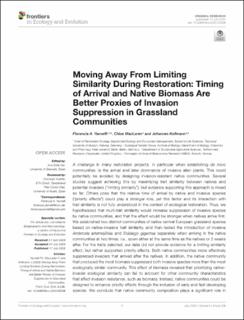| dc.description.abstract | A challenge in many restoration projects, in particular when establishing de novo communities, is the arrival and later dominance of invasive alien plants. This could potentially be avoided by designing invasion-resistant native communities. Several studies suggest achieving this by maximizing trait similarity between natives and potential invaders (“limiting similarity”), but evidence supporting this approach is mixed so far. Others pose that the relative time of arrival by native and invasive species (“priority effects”) could play a stronger role, yet this factor and its interaction with trait similarity is not fully understood in the context of ecological restoration. Thus, we hypothesized that multi-trait similarity would increase suppression of invasive species by native communities, and that the effect would be stronger when natives arrive first. We established two distinct communities of native central European grassland species based on native–invasive trait similarity, and then tested the introduction of invasive Ambrosia artemisiifolia and Solidago gigantea separately when arriving in the native communities at two times, i.e., sown either at the same time as the natives or 2 weeks after. For the traits selected, our data did not provide evidence for a limiting similarity effect, but rather supported priority effects. Both native communities more effectively suppressed invaders that arrived after the natives. In addition, the native community that produced the most biomass suppressed both invasive species more than the most ecologically similar community. This effect of biomass revealed that prioritizing native–invader ecological similarity can fail to account for other community characteristics that affect invasion resistance, such as biomass. Instead, native communities could be designed to enhance priority effects through the inclusion of early and fast developing species. We conclude that native community composition plays a significant role in the establishment success by invasive species, and resource pre-emption seems more significant than trait similarity. In terms of grassland restoration, native species should be selected based on plant traits related to fast emergence and early competitiveness. | en_US |

